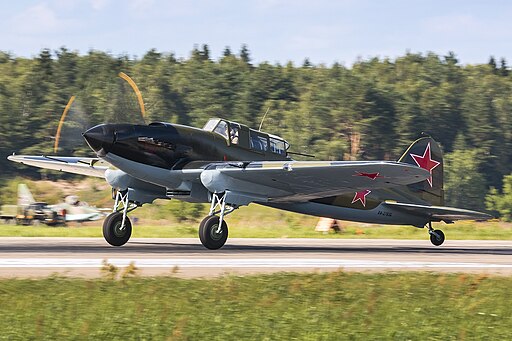In military aviation, few aircraft garner the reverence accorded to the Ilyushin IL-2 Sturmovik. Nicknamed the “Flying Tank,” this Soviet marvel epitomizes the synthesis of engineering prowess and tactical ingenuity, a veritable testament to the fecundity of desperate times. Born in the crucible of the Second World War, the IL-2 operated chiefly on the Eastern Front, offering a manifold lesson in industrial scalability, operational efficacy, and design resilience. Its prodigious impact on ground operations earned it not merely accolades but a legendary status, stitched into the very fabric of modern warfare mythology.
Genesis and Gestation: From Blueprints to Battlefields
The narrative of the IL-2 Sturmovik is intrinsically bound with the intellectual labors of its principal architect, Sergey Ilyushin. Navigating the labyrinthine of Soviet bureaucracy and the whims of political superiors, the Ilyushin managed to progress from initial drafts into an operational asset with remarkable swiftness. The aircraft first spread its wings, metaphorically speaking, on May 30, 1941. It wasn’t an incarnation of aerodynamic finesse or avionic sophistication but rather a practical solution to the exacting demands of modern warfare, specifically the destruction of enemy armor and fortifications.
Structural Alchemy: The Fusion of Armor and Aerodynamics
Perhaps the most arresting feature of the IL-2 was its marriage of armor plating with functional aerodynamics—a herculean task given the contradictory demands of these elements. Encased in a veritable shell of 4 to 5-mm thick armored steel, the cockpit, and vital engine components were safeguarded against anti-aircraft fire and small-arms ballistics. Remarkably, this “beast of burden” maintained a reasonable flight envelope, capable of a top speed of around 257 mph and boasting a range of nearly 500 miles. The balance between durability and performance was nothing short of engineering alchemy.
Armament: The Confluence of Caliber and Capacity
Lest we overlook the aircraft’s armament—a kaleidoscopic array of rockets, bombs, and machine guns, ergonomically arranged for maximum devastation. Originally equipped with a combination of 23mm VYa-23 autocannons and 7.62mm ShKAS machine guns, the IL-2 could deliver a punishing salvo, rendering tanks, trucks, and fortified positions into smoldering detritus. Over time, design iterations accommodated a more diverse arsenal, incorporating anti-tank rockets and even specialized anti-submarine munitions in its repertoire.
Operational Success: A Mosaic of Missions
The significance of the IL-2 Sturmovik’s operational contributions to the Red Army’s ground campaigns cannot be overstated. This robust aircraft displayed exceptional performance in various roles, including close air support, anti-tank operations, and disruption of enemy supply lines. Its widespread prevalence was genuinely remarkable.
At its peak, the IL-2 comprised nearly 30% of the entire Soviet Air Force’s capabilities. Landmarks such as the battles of Kursk, Stalingrad, and Berlin bore the indelible mark of these aircraft, often referred to as “Flying Tanks.” Their presence not only conferred a tactical advantage but also held immense psychological importance, bolstering the spirits of the besieged Soviet forces.
The Lasting Legacy: More Than a Chapter in a History Book
At the culmination of World War II, more than 36,000 IL-2s were manufactured, a figure that boggles the mind even by contemporary standards. But its numerical abundance belies its more profound legacy—a saga of survival, adaptability, and unflinching effectiveness. The IL-2 remains an emblematic case study in the evolutionary trajectory of military aviation, and its design ethos has percolated into contemporary discussions on multi-role platforms and asymmetric warfare.
To behold the Ilyushin IL-2 Sturmovik is to gaze upon a palimpsest of a turbulent era, wherein the imperatives of survival goaded human ingenuity to its apogee. Its story serves as an enduring monument, not just to a machine of war, but to the audacity and resilience of those who conceived, built, and piloted this legendary “Flying Tank.”
For more insights into the Ilyushin IL-2 Sturmovik and other important military aircraft, visit Aces In Action. Here, you’ll find a relic plaque by Craig Tinder titled “WWII Russian Ilyushin IL-2 Sturmovik,” which illustrates the rare artifact, along with the story of the piece, all combined into an attractive, ready-to-hang wood plaque. The relic plaque even includes a piece of an actual aluminum fragment from a Soviet Ilyushin IL-2 Sturmovik ground-attack aircraft acquired directly from the source. It has NEVER been in collectors’ circulation.
WWII Russian Ilyushin IL-2 Sturmovik Relic Plaque by Artist Craig Tinder
This is an actual piece of aluminum from a Ilyushin IL-2 Sturmovik. This is an actual fragment of aluminum from a soviet Ilyushin IL-2 Sturmovik ground-attack aircraft. This relic was recovered outside of St. Peterburg, Russia. With over 40,000 aircraft produced, the IL-2 is the single most produced military aircraft in history.
To purchase or see similar items, visit here.
Commissioned by Museums, Treasured by Collectors





Share:
The Hetzer in the Eastern Front: A Tactical Overview
The Controversy Over Up-armoring: The Debate and the Solutions